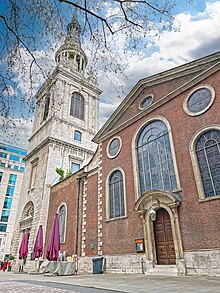
Back كنيسه سانت مارى لو بو ARZ Сент-Мэры-ле-Боу Byelorussian St Mary-le-Bow German کلیسای سنت ماری-له-بو Persian St Mary-le-Bow Finnish St Mary-le-Bow French St Mary-le-Bow Frisian כנסיית סנט מרי לה בו HE St Mary-le-Bow Italian 세인트 메리르보 Korean
| St Mary-le-Bow | |
|---|---|
 View from Bow Churchyard | |
| Location | Cheapside, City of London, EC2 |
| Denomination | Church of England |
| History | |
| Founded | 1080 |
| Founder(s) | Lanfranc |
| Dedication | Mary, Mother of Jesus |
| Architecture | |
| Architect(s) |
|
| Administration | |
| Province | Canterbury |
| Diocese | London |
| Archdeaconry | London |
| Deanery | The City |
| Benefice | St Mary-le-Bow |
The Church of St Mary-le-Bow (/boʊ/) is a Church of England parish church in the City of London, England. Located on Cheapside, one of the city's oldest thoroughfares, the church was founded in 1080, by Lanfranc, Archbishop of Canterbury.[1] Rebuilt several times over the ensuing centuries, the present church is the work of Sir Christopher Wren, following the Great Fire of London (1666). With its tall spire, it is still a landmark in the City of London, being the third highest of any Wren church, surpassed only by nearby St Paul's Cathedral and St Bride's, Fleet Street. At a cost of over £15,000, it was also his second most expensive, again only surpassed by St Paul's Cathedral.[2]
St Mary-le-Bow is widely known for its bells, which also feature in the nursery rhyme 'Oranges and Lemons'.[3] According to legend, Dick Whittington heard the bells calling him back to the city in 1392, leading him to become Lord Mayor. Traditionally, anyone born within earshot of the bells was considered to be a true Londoner, or Cockney.[1]
The church suffered severe damage by the Luftwaffe in the Second World War as part of the Blitz, like many churches in London. The interior was reduced to a shell and though the tower survived, fire damage made the bells crash to the floor. The church was sympathetically restored to its pre-war condition by Laurence King from 1956 to 1964.[4] The church was awarded Grade I listed status, the highest possible rating, on the National Heritage List for England, whilst still a shell in 1950.[5]
- ^ a b "City of London, St Mary le Bow". National Churches Trust. Retrieved 30 November 2022.
- ^ Cobb, Gerald (1977). London city churches. Internet Archive. London : Batsford. ISBN 978-0-7134-3186-5.
- ^ "Bells". St Mary-le-Bow. Retrieved 30 November 2022.
- ^ "St. Mary-le-Bow, Cheapside". English Church Architecture. Retrieved 30 November 2022.
- ^ Historic England. "Church of St Mary-le-Bow (Grade I) (1064696)". National Heritage List for England
© MMXXIII Rich X Search. We shall prevail. All rights reserved. Rich X Search
